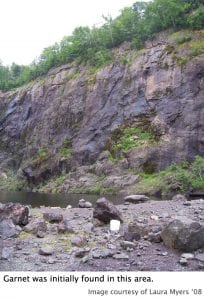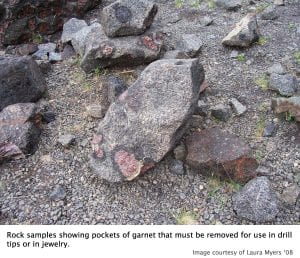 Garnet, the January birthstone and official gem of New York State, is a mineral prized for its beauty but often unrecognized for its practical applications. Garnet jewelry was historically worn by the nobility and upper-middle classes; garnet necklaces dating back to the Bronze Age have been found in the graves of upper-class citizens and in the tombs of some of Egypt’s oldest mummies, used to ward off evil spirits when the deceased person entered into the next world. For centuries, this stone has been a symbol of faith and trust, and gifts containing garnet are seen as a token of loyalty. However, beside its aesthetic value, many of garnet’s qualities like hardness, specific gravity, chemical inertness nontoxicity, and angular fractures have lent themselves to practical applications such as sandpapering, drilling, and polishing glass.
Garnet, the January birthstone and official gem of New York State, is a mineral prized for its beauty but often unrecognized for its practical applications. Garnet jewelry was historically worn by the nobility and upper-middle classes; garnet necklaces dating back to the Bronze Age have been found in the graves of upper-class citizens and in the tombs of some of Egypt’s oldest mummies, used to ward off evil spirits when the deceased person entered into the next world. For centuries, this stone has been a symbol of faith and trust, and gifts containing garnet are seen as a token of loyalty. However, beside its aesthetic value, many of garnet’s qualities like hardness, specific gravity, chemical inertness nontoxicity, and angular fractures have lent themselves to practical applications such as sandpapering, drilling, and polishing glass.
The stone can take on a variety of appearances. Its color can vary from red-brown to gold and light green. However, one clue that can be used to identify garnet is location. Garnet is found in gneisses and schists as well as contact-metamorphic deposits in crystalline limestones, pegmatites, and serpentinites (1). Locations in the United States where garnet is mined include New York, Idaho, Montana, New Hampshire, North Carolina and Oregon (2). The largest garnet reserve is a crystalline gneiss found in North Creek, NY, which I visited this past summer. In the late 1800s, Mr. Barton of North Creek began mining garnet on his land on Gore Mountain, using picks and chisels to etch out the deposits of red-brown stone from surrounding hornsblend and feldspar. He soon developed a small garnet company called the Barton Mines Co (3). In order to extract large amounts of stone faster to be shipped out to waiting jewelry-makers, he began blasting the sides of the mountain with dynamite. However, within a year, they hit the water line and three deep lakes sprung up unexpectedly. Since these lakes blocked access to the quarry, Mr. Barton and his workers moved to another mining site five miles away on Ruby Mountain Garnet mining is still active at that site, and the original site on Gore Mountain is open to tourists (3).
When discussing the composition of a mineral, it is important to consider its physical properties. Garnet is a silicate with the general formula A3B2(SiO4)3 where A can be Mg2+, Fe2+, Mn2+, or Ca2+ and B can be Al3+, Fe3+, or Cr+ (4). It has a crystalline structure of alternating large divalent and small trivalent ions. The divalent ion is surrounded by 8 oxygen atoms, which take the shape of a distorted cube around the single divalent ion. Garnet comes in many colors, but jewelry is usually made with the reddish-brown variety. The stone appears dark brown when extracted from metamorphic rock but can be polished to a reddish tint by jewelry-makers. Garnet is a hard material with a 6.5-7.5 on Moh’s scale of hardness (4). (Diamond, which has a Moh’s hardness rating of 10, is considered the hardest material known to man.).
Garnet can be classified into two general groups based on elemental composition. Pyralopite contains iron, and ugrandite contains calcium. Almandine, for example, belongs to the pyralopute group and is the most common variety of iron-containing garnet. In fact, almandine is the most abundant variety of garnet in the Barton Mine and appears as reddish-brown crystal deposits within large boulders of metamorphic rock. While on our tour of the Barton Mines, we were able to mine garnet ourselves and purchase the unpolished stone for bulk price. Our tour guide showed us how to pour a bucketful of water over the ground and look for pieces of stone bigger than a dime (4). The water helped to wash away dirt from the area and made the stones shinier and easier to locate. We were able to find two pieces of reddish-brown garnet that were approximately 0.5 inches in diameter.
Many industries such as ceramics, glass-making, shipbuilding, and wood furniture operations have used garnet as an abrasive or polishing agent (5). Crushed garnet can be made into sand paper by applying glue to a paper surface, spreading garnet powder over it and allowing it to dry. The powder is very fine and is dark reddish-brown. The finished product sandpaper can be seen on the bottom shelf along with the tools used to make it.
Garnet is used in a variety of other applications such as grinding plate-glass and polishing optical lenses because it is fairly inexpensive and extremely hard. In fact, a piece of garnet from the Barton Mine was used to polish the Hubble Telescope (4). Garnet is also used in the scratch-free lapping of semiconductor materials and is currently replacing silica sand in blast cleaning media because it does not produce dangerous airborne dust. Finally, it is used for blast cleaning aluminum surfaces on aircrafts and cleaning drill pipes in the petroleum industry (5).
The industries that currently consume the most garnet are those that use water jet cutting to cut materials such as steel (5). It uses a jet of water at either high velocity or pressure and an abrasive surface to cut through material; essentially, an accelerated version of water erosion is used to make metal parts for machinery. Garnet is added to increase the abrasive power of the steam. This technology has reduced the difficulty and cost of cutting hard materials, and is used in mining and the cutting of parts for household appliances or motors.
 Recent statistics show that the US continues to be one of the leading consumers of industrial garnet. In 2005, the US accounted for over 35% of global garnet consumption, which totaled 68,600t (5). Since the 1990s, however, the amount of garnet bought from foreign exports in domestic markets has begun to exceed the amount bought from domestic production. Prices of garnet vary depending on application, quality, quantity purchased, source, and type. In 2005, the price of crude garnet ranged from $58-120 per metric ton with an average of $96 per metric ton, while the price of refined garnet ranged from $61-298 per metric ton with an average of $268 per metric ton (5). It is thought that the demand for garnet polishing powders commonly used in polishing television and monitor screens will decline as flat screen technology takes hold of the television industry, since flat screens do not need to be polished by garnet during the manufacturing process (5).
Recent statistics show that the US continues to be one of the leading consumers of industrial garnet. In 2005, the US accounted for over 35% of global garnet consumption, which totaled 68,600t (5). Since the 1990s, however, the amount of garnet bought from foreign exports in domestic markets has begun to exceed the amount bought from domestic production. Prices of garnet vary depending on application, quality, quantity purchased, source, and type. In 2005, the price of crude garnet ranged from $58-120 per metric ton with an average of $96 per metric ton, while the price of refined garnet ranged from $61-298 per metric ton with an average of $268 per metric ton (5). It is thought that the demand for garnet polishing powders commonly used in polishing television and monitor screens will decline as flat screen technology takes hold of the television industry, since flat screens do not need to be polished by garnet during the manufacturing process (5).
On the other hand, recent increases in petroleum prices have caused high demand for new sources of oil, which may, in turn, increase the demand for garnet, as it is used in cleaning drill pipes (5). Since oil has become and important source of energy, however, other types of fuel have been developed such as vegetable oil and hydrogen. It will be interesting to see which sources of fuel power the new millennia. The steam engine powered most of the Industrial Revolution, so it is possible that another fuel source — a newly refined oil, a controlled type of hydrogen fusion, or a material undiscovered as of yet–may fuel a second Industrial Revolution in the future. If oil becomes the fuel of choice, garnet will be valuable as a component of the cleaning media for drill pipes.
While new uses for garnet are being developed every day, it is still common in jewelry. In fact, there is a small jewelry store adjoining the Barton Mines Museum that sells necklaces, earrings, and rings made of garnet. Some pieces of garnet jewelry are made with a combination of garnet and other gems such as diamond and mounted on silver or gold. Prices for the finished product vary according to the size and purity of the garnet as well as the value of the stones surrounding the garnet. For example, a necklace mounted in silver with a precious garnet the size of a pinky-fingernail cost about $24; the same necklace mounted in gold was $37. Of course, this price accounts for the extraction, processing, polishing, and mounting of the stone and includes the amount charged for the garnet, mounting, and the labor that went into producing the finished product. A cost analysis of the jewelry sold in this store was conducted based on estimates from July 8, 2006. On our tour we found that the stone carried out from the mine cost $1/lb, and we can estimate that a stone of the size in the aforementioned necklace would weigh about 3g (0.007lb), so if mined directly, the garnet should cost no more than a penny. Thus labor and mounting cost far more than the stone itself, illustrating that while pure garnet is a high quality stone, it is great for budget-conscious consumers.
The Gore Mountain Mine is an important reserve of garnet in the world, located in an area not yet too industrialized: the museum is a classic rural upstate New York building without air conditioning; the tour was given by a student whose summer job was to work at the museum store; and the road leading to the mine is not yet paved and winds around the mountain with hairpin turns every 50 meters. The area has remained a place of natural beauty, so far spared from seizure of its material resources. It is valuable to visit the Barton Mine in order to understand how materials can be extracted from the earth and put to use for both practical and aesthetic purposes. Garnet may even be used in more diverse applications as new technology continues to develop.
References:
1. O. Johnson, Minerals of the World, Princeton Field Guides (Narayana Press, Princeton and Oxford, 2004) pp. 29-32, 68-69.
2. O. Johnson, Minerals of the World, Princeton Field Guides, Narayana Press, Princeton and Oxford, 68.
3. Garnet Mines Tour, Barton Mines, Gore Mountain, Long Lake, NY, July 8, 2006.
4. O. Johnson, Minerals of the World, Princeton Field Guides, Narayana Press, Princeton and Oxford, 2004.
5. D. Olson, Minerals Yearbook, 2005, pp. 29-32, 68-69. Acced online on August 15, 2006 through Kresge Physical Sciences Library’s link to sources on mineralogy, pp. 28-32.
Peter Lennon
Hey guys, thanks for putting together a very informative article. I would have liked to have taken this tour myself.